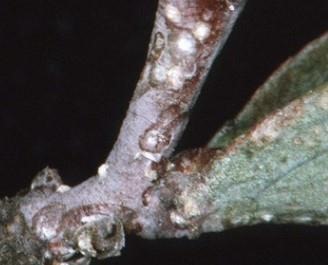By Kathy Demchak
While there are over 20 different species of scale insects known to affect blueberries in the northeastern U.S., Putnam scale has been the one most commonly found in commercial plantings. The first symptom noticed is often a decrease in the vigor of the plants, though, in the case of Putnam scale, tiny dots on the fruit, canes, or leaves also may be noticed.

Putnam scale (Diaspidiotus ancylus) (Putnam) infestation on blueberry (Vaccinium spp. L.) Image: John .A. Davidson, Univ. Md, College Pk, Bugwood.org
Scale insects in general are worse in plantings that have many old canes and least problematic in plantings that are regularly and thoroughly pruned. The scale insects prefer living where they are protected. Since older canes have rough shaggy bark and good hiding places, the problem may not be detected and populations may build over time. While the scale insects may be found on other plant parts, including the fruit, this is thought to occur when populations are already plentiful under the bark. Since spotted wing drosophila has increased the need for certain insecticide sprays during the harvest season, populations of the many natural enemies of scale insects may be negatively impacted, possibly making issues with scale insects more common.
In the case of Putnam scale, in particular, identification and understanding the life cycle is tricky. The color of Putnam scale varies with the location where it "settles" on the plants, making identification challenging. The settled scale looks like a small raised waxy dot on canes, leaves, or fruit, and often fruit is dimpled where the scale is feeding. If the scale covering is lifted, the insect itself may be seen, but that would require the assistance of a hand lens or magnification for good visibility. Further, whether one or two generations per year occur throughout Pennsylvania is unclear. One generation per year was documented in the 1970s in Pennsylvania, while a detailed study conducted in southern New Jersey in the late 1990s by Sridhar Polavarapu confirmed two generations per year there. Putnam scale insects overwinter as second-instar nymphs, which then progress through three more instars in late winter and early spring. The last of these (the adults) lays eggs in late spring, from which crawlers hatch. The crawlers find new locations to feed and settle on the plant, either under the bark or elsewhere if populations are high, possibly including fruit. If there is a second-generation, the cycle repeats and a second "wave" of crawlers emerges in mid-summer which then look for locations where they can overwinter.

Putnam scale (Diaspidiotus ancylus) (Putnam) on rabbit-eye blueberry (Vaccinium virgatum Ait.) Image: Jerry A. Payne, USDA Agricultural Research Service, Bugwood.org
One key in controlling scale insects, in general, is to prune thoroughly and keep the canes young. By providing fewer hiding places for all life-cycle stages, natural enemies are more likely to find pests and keep populations in check. Dormant oil (with or without pyriproxyfen - trade name Esteem) applied before bud-break in spring is effective if high water pressure and volume are used. Make the application when temperatures are well above 40 degrees, as damage can occur if temperatures drop below freezing after application. Alternatively, lime sulfur alone, also in high volumes of water to get good coverage under the bark, is effective. Dormant oil and lime sulfur should not be applied within 14 days of each other as phytotoxicity is likely to occur.
While these are the main methods of control, an additional but more nuanced approach is to add an Esteem spray application targeting crawlers in late spring (and in mid-summer if a second generation is present—watch the 7-day PHI on blueberries). It will be difficult to know the correct timing without monitoring. Monitoring requires using double-sided white or black sticky tape to improve visibility and detect crawlers when they are on the move. They are unprotected by a waxy coating and susceptible to insecticides at this time. As always, make sure that the products you are using are legal for use in the state where your farm is located, and follow all instructions that appear on the label.
Source : psu.edu